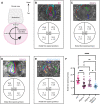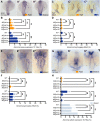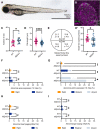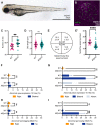Sequential action of JNK genes establishes the embryonic left-right axis
- PMID: 35352808
- PMCID: PMC9148569
- DOI: 10.1242/dev.200136
Sequential action of JNK genes establishes the embryonic left-right axis
Abstract
The establishment of the left-right axis is crucial for the placement, morphogenesis and function of internal organs. Left-right specification is proposed to be dependent on cilia-driven fluid flow in the embryonic node. Planar cell polarity (PCP) signalling is crucial for patterning of nodal cilia, yet downstream effectors driving this process remain elusive. We have examined the role of the JNK gene family, a proposed downstream component of PCP signalling, in the development and function of the zebrafish node. We show jnk1 and jnk2 specify length of nodal cilia, generate flow in the node and restrict southpaw to the left lateral plate mesoderm. Moreover, loss of asymmetric southpaw expression does not result in disturbances to asymmetric organ placement, supporting a model in which nodal flow may be dispensable for organ laterality. Later, jnk3 is required to restrict pitx2c expression to the left side and permit correct endodermal organ placement. This work uncovers multiple roles for the JNK gene family acting at different points during left-right axis establishment. It highlights extensive redundancy and indicates JNK activity is distinct from the PCP signalling pathway.
Keywords: Cilia; JNK; Kupffer's vesicle; Laterality; PCP; Zebrafish.
© 2022. Published by The Company of Biologists Ltd.
Conflict of interest statement
Competing interests The authors declare no competing or financial interests.
Figures








Similar articles
-
Klf8 regulates left-right asymmetric patterning through modulation of Kupffer's vesicle morphogenesis and spaw expression.J Biomed Sci. 2017 Jul 17;24(1):45. doi: 10.1186/s12929-017-0351-y. J Biomed Sci. 2017. PMID: 28716076 Free PMC article.
-
Dvr1 transfers left-right asymmetric signals from Kupffer's vesicle to lateral plate mesoderm in zebrafish.Dev Biol. 2013 Oct 1;382(1):198-208. doi: 10.1016/j.ydbio.2013.06.011. Epub 2013 Jun 17. Dev Biol. 2013. PMID: 23791819 Free PMC article.
-
The Rho kinase Rock2b establishes anteroposterior asymmetry of the ciliated Kupffer's vesicle in zebrafish.Development. 2011 Jan;138(1):45-54. doi: 10.1242/dev.052985. Epub 2010 Nov 23. Development. 2011. PMID: 21098560 Free PMC article.
-
Left-right asymmetry in zebrafish.Cell Mol Life Sci. 2012 Sep;69(18):3069-77. doi: 10.1007/s00018-012-0985-6. Epub 2012 Apr 19. Cell Mol Life Sci. 2012. PMID: 22527718 Free PMC article. Review.
-
Cilia in vertebrate left-right patterning.Philos Trans R Soc Lond B Biol Sci. 2016 Dec 19;371(1710):20150410. doi: 10.1098/rstb.2015.0410. Philos Trans R Soc Lond B Biol Sci. 2016. PMID: 27821522 Free PMC article. Review.
Cited by
-
Breaking Left-Right Symmetry by the Interplay of Planar Cell Polarity, Calcium Signaling and Cilia.Cells. 2024 Dec 20;13(24):2116. doi: 10.3390/cells13242116. Cells. 2024. PMID: 39768206 Free PMC article. Review.
-
Understanding laterality disorders and the left-right organizer: Insights from zebrafish.Front Cell Dev Biol. 2022 Dec 23;10:1035513. doi: 10.3389/fcell.2022.1035513. eCollection 2022. Front Cell Dev Biol. 2022. PMID: 36619867 Free PMC article. Review.
-
REDOX Balance in Oligodendrocytes Is Important for Zebrafish Visual System Regeneration.Antioxidants (Basel). 2023 Nov 22;12(12):2026. doi: 10.3390/antiox12122026. Antioxidants (Basel). 2023. PMID: 38136146 Free PMC article.
-
JNK regulates ciliogenesis through the interflagellar transport complex and actin networks.J Cell Biol. 2023 Nov 6;222(11):e202303052. doi: 10.1083/jcb.202303052. Epub 2023 Oct 18. J Cell Biol. 2023. PMID: 37851005 Free PMC article.
References
-
- Antic, D., Stubbs, J. L., Suyama, K., Kintner, C., Scott, M. P. and Axelrod, J. D. (2010). Planar cell polarity enables posterior localization of nodal cilia and left-right axis determination during mouse and Xenopus embryogenesis. PLoS One 5, e8999. 10.1371/journal.pone.0008999 - DOI - PMC - PubMed
Publication types
MeSH terms
Substances
Grants and funding
LinkOut - more resources
Full Text Sources
Molecular Biology Databases
Research Materials
Miscellaneous

